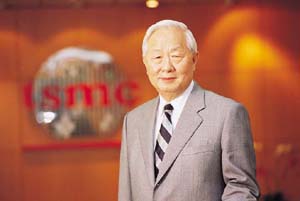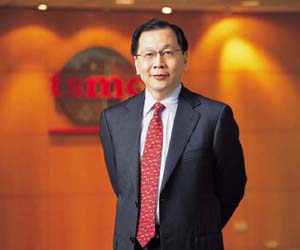Change at TSMC Top Management Arouses Concern
2009/06/23 | By Ken LiuNo one doubts that Morris Chang is qualified to be CEO of the Taiwan Semiconductor Manufacturing Co. (TSMC), but some may question why he reclaimed that position at a time when the foundry giant had already emerged from the worst days of the global economic recession instead of when it was in deep difficulty.

The TSMC board of directors re-elected Chang chairman and approved his appointment as CEO on June 11. Rick Tsai was appointed to head the company's New Business Development Organization, which was established to venture into areas outside the field of silicon foundry.

Chang went on to say, "TSMC's core foundry business is extremely demanding," making it "hard for Rick Tsai to handle the job of CEO of TSMC and president of the new business organization at the same time."
The new personnel arrangement took most foreign institutional investors by surprise and made them wonder if something is amiss. They oversold 48.7 million TSMC shares on the day following the announcement; some analysts have downgraded their rating of TSMC stock from "buy" to "neutral" and have cut its target price at NT$55, compared with a high of NT$60 in recent trading. Goldman Sachs even removed TSMC from its priority-buy list of Asia-Pacific high-tech stocks.
These moves reflect concerns about the company's leadership succession and uncertainty about its profit drivers over the next four to five years. They wonder who will take over TSMC after Chang, since it takes a lot of time to train the leader of such a large enterprise. These worries are especially pertinent in view of the fact that the positions of group president and chief operating officer of TSMC remain vacant, since these are generally considered as stepping stones to the post of chief executive.
Some industry watchers contrast TSMC with arch-rival United Microelectrronics Corp. (UMC), the leadership of which has been passed from Robert Tsao and John Hsuan to Jackson Hu and on to Stan Huang and S.W. Sun.
Some institutional investors have told their clients that Chang believes TSMC is still in rough water and that Tsai is not capable of coping (this despite the fact that Barron's has listed Tsai as one of the 30 most respected CEOs in the world). Others think the move reflects concerns about the future profitability of the chip foundry industry.
From 2001 through last year TSMC's revenue rose 65%, from NT$125.9 billion (US$3.8 billion at NT$33:US$1) to NT$333.1 billion (US$10 billion). Last year its annual growth rate slowed to 3.3%, from a high of 26.8% in 2004. Tsai's new business organization has been given a target of US$2 billion in revenue in 2018 and a contribution of 1.5 percentage point of TSMC's projected 4.5% compound annual growth rate (CAGR).
Chang insisted that Tsai's transfer was an adjustment and not a demotion, since he will still report directly to Chang; some industry analysts cannot help but think about mistakes that Tsai made during his days as CEO. He has been blamed for laying off hundreds of underperforming employees (by TSMC standards), losing ground to No. 2 player UMC and No. 3 producer Semiconductor Manufacturing International Corp. (SMIC) in the 0.13-micron foundry business, and failing to bring the 40mn process into commercial production as scheduled.
At an executive conference a few weeks ago, Chang commented that TSMC still has plenty of room to improve customer satisfaction, gross margins, and sales from mainstream foundry processes.
The employee layoffs led to protests in front of Chang's Taipei residence, upsetting him and damaging TSMC's long-standing image as a company that takes good care of its people.
The company's unsteady upgrade to the 40nm process has reportedly elicited complaints from Nvidia and AMD, who plan to have their chips made with the new leading-edge process at TSMC's 300mm wafer fabs in the second half of this year. They need this to make their products more competitive during the back-to-school and Christmas shopping seasons.
Some observers say that these criticisms are unfair to Tsai, because he kept average earnings per share at NT$4.31 during the first three years of his stewardship. This is a bit better than Chang's performance during his 11 years at the top of the company, when average EPS was NT$4.14. Also, during his term Tsai lengthened TSMC's leadership over UMC.
Upon taking over his new position, Tsai said, "I am pleased and honored to be given this great opportunity to contribute to TSMC's long-term growth. I will meet the challenge with all my strength." Tsai's success will depend largely on the solar energy and LED (light emitting diode) businesses. He is optimistic about the long-term prospects of the solar-power market, he said, although the industry is now being battered by excessive supply.
TSMC has no production facilities or management teams to handle these two businesses, so everything will have to start from scratch. Tsai commented that he might jump-start the process through M&A. Industry insiders expect TSMC to enter into an alliance with the Neo Solar Power Corp, a solar-cell maker that was founded by Quincy Lin, TSMC's former senior vice president.
Tsai said that the new business operation will not likely follow TSMC's traditional contract-manufacturing model, but will probably build up its own brand names. The company is by no means a complete stranger to the LED business, having invested in American manufacturer BridgeLux through one of its venture capital funds, has begun setting up a related patent bank, and has launched the pilot production of epitaxy wafers using some obsolete metal oxide chemical vapor deposition chambers. It has also won the world's second-largest number of solar-cell patents.
Some people think that Tsai might one day return to the position of CEO. Others are betting on Jason Chen, TSMC's vice president for worldwide sales and marketing, or Thomas J. Engibous, an independent director and former chairman of Texas Instrument (Morros Chang was once TI's group vice president).
Most observers think that whoever may eventually succeed him as CEO, Morris Chang's undisputed charisma may help TSMC win new contracts and retain old customers; in addition, his personal prestige in the semiconductor community, and particularly in Beijing, should help the company expand its turf in mainland China.
TSMC Revenue and Return on Investment, 2001-2008
2001 | 2002 | 2003 | 2004 | 2005 | 2006 | 2007 | 2008 | |
Revenue | NT$125B | NT$160B | NT$201B | NT$255B | NT$266B | NT$317B | NT$125B | NT$160B |
Change | -24.5% | 27.9% | 25.4% | 26.8% | 4.1% | 19.1% | -24.5% | 27.9% |
ROE | 5.4% | 7.5% | 15.1% | 25.4% | 22.2% | 26.6% | 5.4% | 7.5% |
Source: TSMC




